Category: Uncategorized (Page 2 of 4)
Troy Shaffer
Dr. Hildebrandt
CODES122
16 April 2024
Mixed Methods Lab
Our final lab for our research team was broken into two parts, we made a survey about Indigenous Knowledge in Missouri Botanical Gardens (MOBOT), as well as did a focus group with several members of the staff also about Indigenous Knowledge in MOBOT. Unfortunately, with our surveys, we did not get the number of responses we aimed for, with only 7, but 7 is better than none. I would say that the focus group was definitely a better experience overall and helped us get better responses to our questions, due to the fact that we were face to face. When you are face to face, you aren’t given much time to think about the perfect answer, like with an online survey, so with the focus group interviews, I feel like we got more raw honest answers
Our focus group interviews were supposed to fill in the gaps from the questions in our surveys, however our surveys did not do well. So, we had to reword some questions to help us get more information that was lacking from our survey responses. The picture below is a word cloud from one of our interviews. One obvious pattern was seen with our focus group interviews, and it was with our last question, “What knowledge should be honored or protected within the information gathered?”. Almost all of the staff responded said something along the lines of that everything is voluntary, and all information is accurate. We got good responses from everyone we interviewed, but at some points it sort of felt like they were media trained with their answers.

Our surveys were a struggle. It took forever for us to get responses, only to end up with seven total. But our survey was directed towards staff members at MOBOT, and asking them about Indigenous Knowledge and its place at MOBOT. One of our questions was “How have you seen the garden portraying Indigenous Knowledge?”. One response we got was quite interesting, “We could be doing more, I actually have a hard time thinking of examples when the Garden has handled this topic well. I can actually think of more examples of times the gardens missed opportunities to present local knowledge very well through social media and local TV/radio spots (Kwanzaa, Indigenous Peoples Day, and Japanese Festival)”. This just shows that one of the biggest problems and issues is actually acknowledging the problem.
Kasey Tipton
April 11, 2024
Our group’s focus is on Indigenous knowledge within the Missouri Botanical Gardens. Our research question is, “How is Indigenous knowledge lacking within the garden?” Our priority is finding the gaps of Indigenous representation. We used two mixed methods, interviews and surveys, in order to collect data. Our survey had received 7 responses and we interviewed 6 people. Doing the small focus groups helped us receive more nuanced explanatory data. However, I think surveys and interviews are both important in gathering data.
Our survey responses left some blank areas within our data. Furthermore, not only did we only have 7 responses, but some people did not answer specific questions. With that being said, our interviews went a lot smoother. People were able to be descriptive and more thorough with their responses. It seemed easier to people to answer questions in person, rather than thinking about what to type on a survey. Along with this point, in the interviews, people seemed to think longer to answer the same questions. If our group could do this differently in the future, we would try to stick to the idea of larger focus groups (rather than two people at a time) because it improves our data when people can bounce ideas off of each other and add to what others say.
The results of our data will help our group tremendously. It has shown us different areas that already include Indigenous knowledge. On the other hand, it has shown us areas of improvement. We can use this information to figure out how to portray Indigenous knowledge evenly throughout the garden. Our interviews overall had similar responses with the survey. For example, our question, “Where do you think Indigenous Knowledge belongs in the garden?” A lot of our responses said that it should be easily accessible in places that involve Indigenous knowledge. In another word, everywhere. One of the most important notes that was given was for us to help the garden improve on allowing for Indigenous knowledge to be important year round. Rather than celebrating it for a specific month/week. This point helped
Using mixed methods on this topic was very important. It gave us multiple different viewpoints on these important topics. Even though our survey and interviews went very well, I think it would be important to hear about how the public feels about Indigenous knowledge. I would like to hear the perspectives of the garden visitors and if they have even heard of Indigenous knowledge within the garden.
In our findings within the CODES research teams, my team dove into the history of African American knowledge within the garden. We discovered that the contributions of enslaved people to botany often go unrecognized or unacknowledged. These enslaved individuals lacked proper credit for their botanical discoveries. We aim to rectify this injustice by centering their stories and prioritizing reparative justice throughout our research. This semester we used surveys as a tool to hear directly from MOBOT. Our questions included some of the following: “How well do you think the gardens currently represent African American culture, history, and contributions?” and “What strategies or approaches do you suggest for effectively integrating African American knowledge into the garden’s initiatives?”.
In analyzing the findings from both the survey and my time conducting research with my team, several themes and patterns emerged that shed light on the significance of Black representation and engagement within the gardens. Many participants believe the garden does a slightly good job at representing African American Knowledge, some say not well at all.
One significant theme that emerged was the desire for more diverse programming and representation within the Gardens. Many desire to see more events, exhibitions, and educational programs that highlight Black culture, history, and contributions to the field. One response from the survey states we can do the following: “Signs all around the garden. Celebrating and highlighting African American holidays, history, community, events, and employees. Opening access to the garden for efficiency.” This theme is particularly significant as these challenges of botanical gardens are solely dedicated to the study of plants and biodiversity, highlighting the need for these spaces to also serve as platforms for cultural exchange and celebration.
Something I found interesting while conducting the in-person interviews with the MOBOT employees was the significance donors have to the garden. Most, if not all donors at MOBOT are older, white, and upper class, and because they have a voice in where their money goes, African American Knowledge is not a top priority for most unfortunately. What can be done about this? Diverse programming and representation within the Gardens would be great. There is a huge lack of diversity within the staff and I believe donors can help with this problem. Donors can establish endowments to provide scholarships and fellowships for African American students and researchers interested in studying botany and related fields. By providing financial support for education and training opportunities, donors can help cultivate the next generation of African American botanists and scientists, ensuring their knowledge and perspectives are represented and valued within the botanical community. Many participants in the survey were white, this continues the need for diversity within the garden.
Moving forward, our research indicates the need for the Missouri Botanical Garden to confront and address the historical injustices perpetuated against enslaved individuals. This might involve initiatives such as creating educational programs and exhibits that highlight the contributions of enslaved botanists, establishing partnerships with descendant communities, and implementing policies that prioritize reparative justice. By centering the stories of these individuals, the Garden can work towards creating a more inclusive and equitable environment for all visitors.
Evitt Nashed
April 10th, 2024
Our Final Lab for Codes 122 was a conducted survey that was sent out to the public and MOBOT researchers to get a more thorough understanding of our wicked problem. My group’s survey was about the lack of knowledge within the MOBOT about indigenous knowledge. We decided to ask a series of questions in our survey about indigenous knowledge in the MOBOT and what we would get as a result to help us resolve this wicked problem. We only got 7 responses to our survey, which was less than we thought but was better than nothing! The people who participated in our survey ranged from research and department leaders to graduate students, scientists, and even librarians.
One of our questions was, “What does indigenous knowledge mean to you?” A couple of people responded with traditional and environmental knowledge used for their benefit. Another answer we got was Any specialized environmental knowledge from a local group. They also gave us examples like Indigenous folks, organic gardeners, and craftworkers. We also had two responses about Robin Wall Kimmerer’s work and book about correlations of “native” and “Western” taxonomies: even Sacajawea’s role in the Lewis and Clark Voyage of Discovery.
Another question in our survey was how we can implement indigenous knowledge into the gardens. We got good answers about implementing research they conducted in the Madagascar Program. Another way we can incorporate indigenous knowledge is through exhibits, and also continuing to incorporate this into Western scientific research from the garden. Mostly, all researchers claimed that indigenous knowledge should be implemented everywhere in the MOBOT.

One of our last questions was about how indigenous knowledge should be showcased. These survey takers thought that museum exhibits and signs in the garden were good examples of showcasing indigenous knowledge. Other examples could be tours or guest speakers talking about the use of indigenous knowledge. A linkage I found within all these answers for this specific question is that all of them preferred signage as a good way to spread the word about indigenous knowledge. Signage is the design or use of signs to get a message to the public.
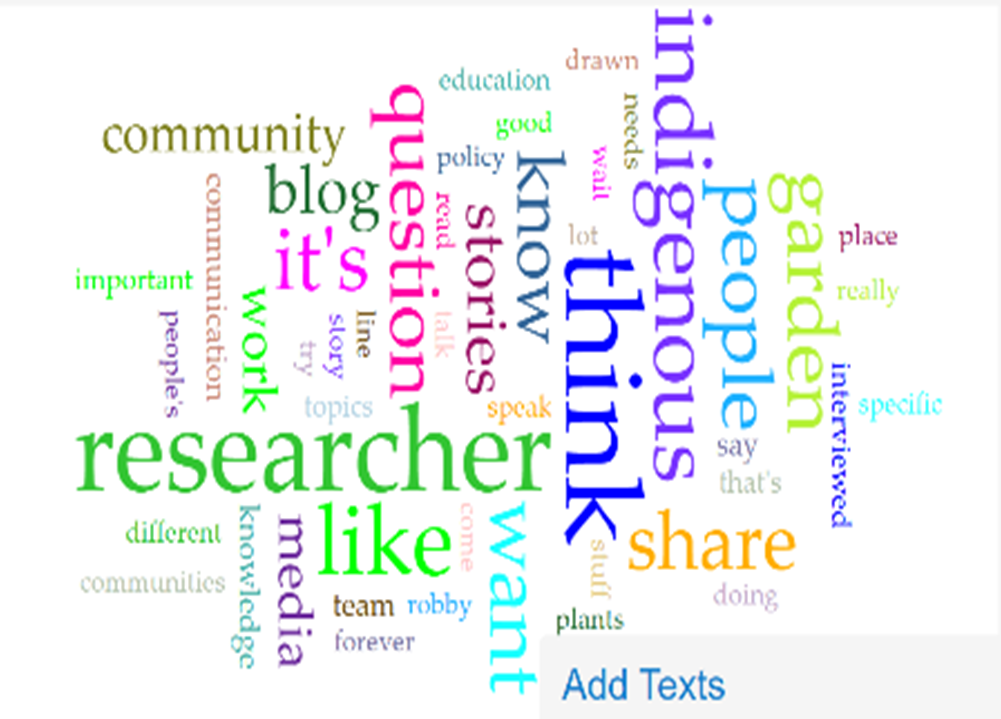
This survey overall helped us fill in the gaps and missing pieces of what we wanted to know about indigenous knowledge. Our surveys also helped to raise awareness about indigenous knowledge and why it should be implemented in the Gardens. Indigenous knowledge can give us insights into how these certain people lived and survived with only their natural resources. We can use this information to make MOBOT a less Westernized facility.
Even though we got good responses to our survey, MOBOT still has qualitative challenges and problems that are hard to fix. Libraries, databases, and archives can be one example of a challenge the garden faces where the knowledge is broad, but not deep. Another challenge is that it is difficult to get more detailed information from indigenous communities because meaningful and sustained community connections take much time to receive. Many indigenous people do not have the communication resources we have so it takes a good amount of time to get good information.
The instructions for the final lab write up:
- Contextualize and interpret themes and patterns. Why are they surprising or significant? How do they support or challenge your prior knowledge?
- Mixed methods research allows us to approach a question from multiple angles to gain breadth and depth of understanding. How do your results relate to your survey? Did the qualitative study fill in the gaps you hoped it would? Did the results support your initial conclusions? Did they reveal complexity or tensions? Did they challenge them entirely?
- In addition to exploring the data, also reflect on your research design. Did you learn everything you need to know? How might you design the study differently next time to encourage more detailed or accurate information?
- While mixed methods research gives us a more holistic perspective on our topic than a single method, this doesn’t mean there’s nothing left to learn or that you’ve answered every question completely! Research is iterative – that means that we keep coming back to our topic in different ways to build up layers of knowledge and understanding. So, reflecting on what you’ve done so far, what else do you want to know?
Phase one
Surveys
My group includes Jay, Jaidyn, and Sophia. We are focusing on “how does colonialism affects the garden and the herbarium”. This lab has two parts, the first part was our surveys, and the second part of the lab was the focus groups we conducted. Our surveys kind of fell off and didn’t get the attention of the garden partners like we were hoping to get. At the end of that phase of our lab, we ended up only getting one response all together. Which was kind of disappointing for me and my team because we worked really hard on the survey, formulating specific questions and strategizing for weeks. So, we had to ask ourselves “what exactly did go wrong”, with our surveys. The topic of our research question has an “uncomfortable ” aura around it already because it is a heavy topic, but it is still a very important topic to talk about and raise awareness about it. the best thing that we could think is that maybe our surveys were asking too “heavy” of questions for a survey. Here below is an example of some of our surveys.
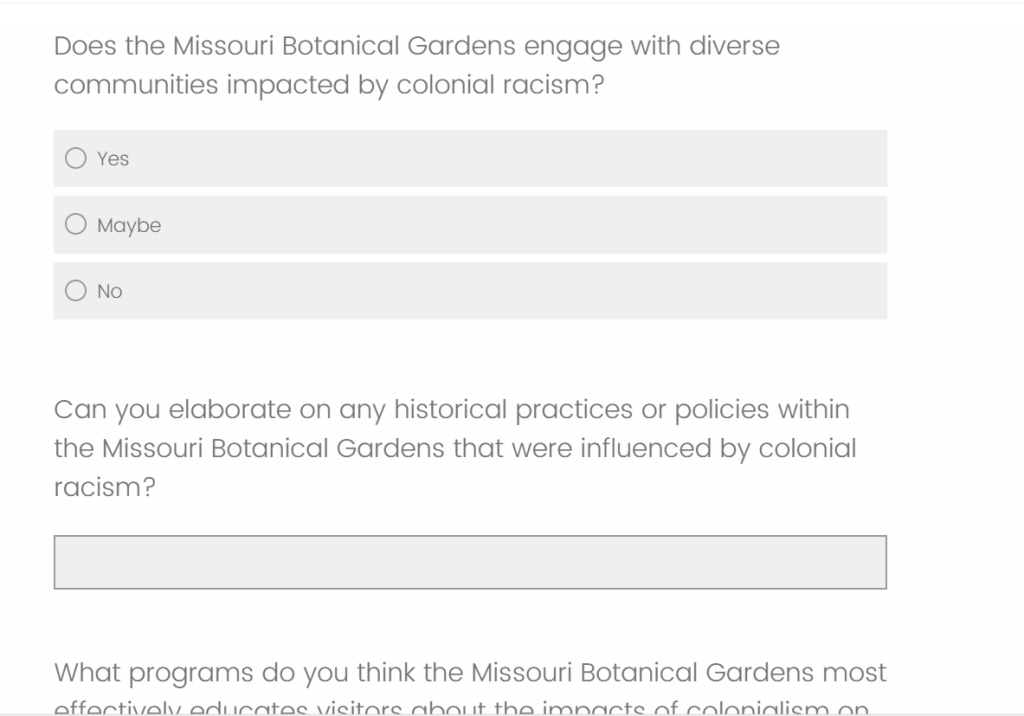
Phase Two
FOcus Groups
After carefully analyzing the feedback, we got back from our initial survey (though it consisted of just one response), we realized that the needed to refine and rephrase certain survey questions for greater clarity and relevance. Additionally, recognizing the value of soliciting insights directly from our garden workers, we decided to craft new inquiries and discussion points tailored to their expertise and experiences. As we prepared for the focus groups, we identified a diverse array of individuals within the garden community whom we sought to engage with our inquiries. Through collaborative effort, we formulated a comprehensive set of questions designed to get a nuanced perspectives and valuable insights. Below, are the refined and expanded list of questions that emerged from this iterative process:
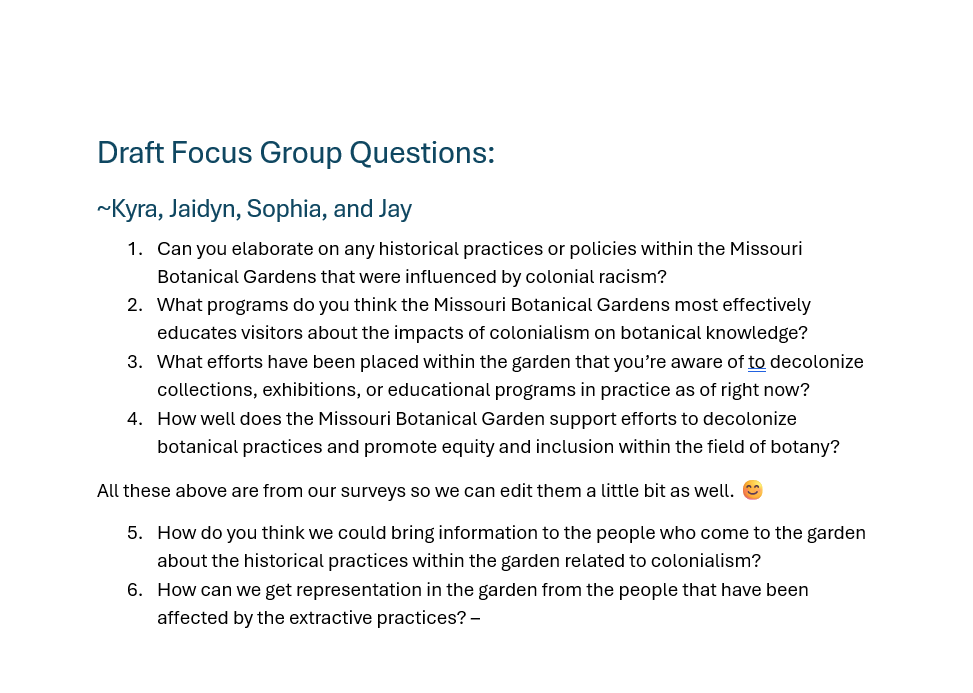
Phase Three
Data analysis and data cleaning
In our recent tactics, our focus has been keenly directed towards the meticulous realms of data analysis and data refinement. This phase entailed a comprehensive set of data procured from various surveys and focus groups, followed by an intricate process of scrutiny and interpretation. Our aim was not merely to compile information but to look deeper into the narrative within the datasets to hopefully steer our future actions regarding the development of the untold history and extractive processes at the gardens.
We also wanted to employ a sort of systematic approach. So, with each focus group transcript was processed into a suitable and a form of analytical platform. Through this arrangement, we sought to look at recurring themes and patterns, unraveling the complex threads of responses across the focus groups. This examination not only facilitated a nuanced understanding of the collected data but also unveiled potential avenues for further exploration for the garden.
The breadth of perspectives and experiences shared by participants underscore the significance of our research endeavors. The insights we found through our analytical endeavors serve as a compass, guiding us towards the formulation of a plan that aligns with our overarching objectives and research question. With a clearer vision and a more comprehensive understanding of the past, we are better equipped to navigate the complexities of our WICKED problem, paving the way for a hopeful meaningful progress and sustainable growth in the Missouri Botanical Garden.
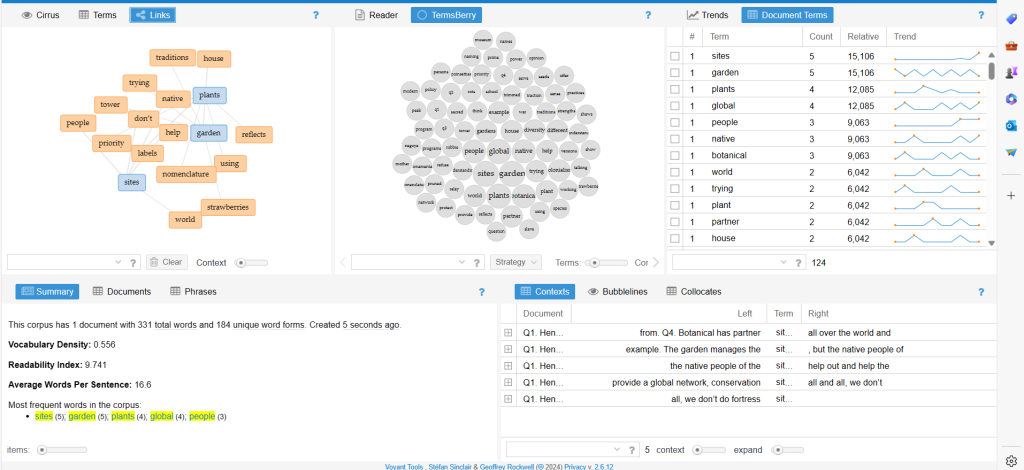
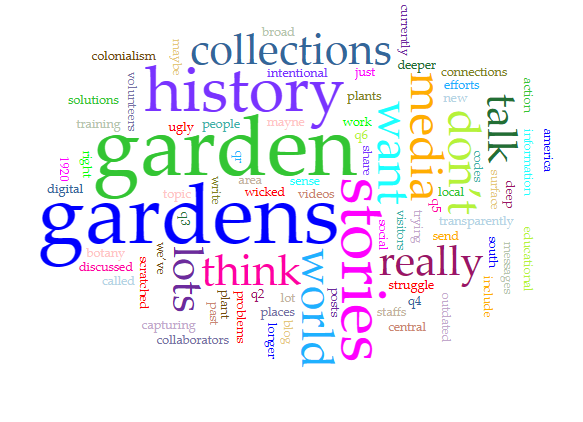
Our data after being put into Voyant.
Voyant Tools. https://voyant-tools.org/. Accessed 11 Apr. 2024.
Missouri Botanical Garden. https://www.missouribotanicalgarden.org/. Accessed 11 Apr. 2024
STEP ONE: SURVEYS
These surveys have been through the ringer. It was a difficult task to get responses on them for multiple reasons. In the end it took over a month to get responses on the surveys. The purpose of the survey was to have a specific audience based on the greater research question. The final goal was to ask these specific groups questions to gain their insight on progress that the research teams have made so far. The survey questions were about Indigenous knowledge and where this wicked problem currently places within the multitude of wicked problems present at MOBOT.
One of the questions asked was “Based on your answer to the prior question, how have you seen the Garden portraying Indigenous knowledge?” For some context, the previous question pertained to what the phrase Indigenous knowledge meant to them. One of the responses to this question was moving. The response was “We could be doing more. I actually have a hard time thinking of examples when the Garden has handled this topic well. I can actually think of more examples of times the Garden missed opportunities to present local knowledge and didn’t promote them very well through social media and local TV/radio spots (Kwanzaa, Indigenous Peoples Day, Japanese Festival).” This response shows one of the main HUGE aspects about a wicked problem that takes forever to be known. What I am speaking of is ACKNOWLEDGING THE PROBLEM!! Based on the other responses, no one else acknowledged or shed light on the fact that more needs to be done.G
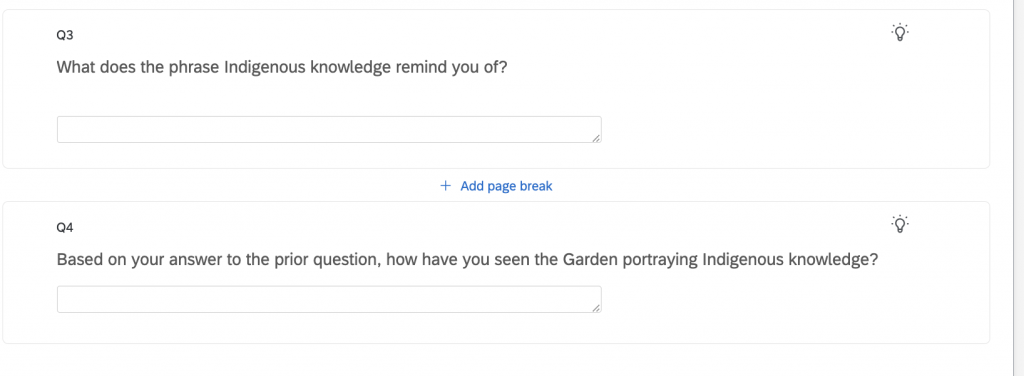
STEP TWO: FOCUS GROUPS
The next step that was supposed to happen was that based on the survey responses, we were supposed to take a deeper dive into the responses that we received. We were then supposed to build a different set of questions to help us understand why one group of answers on the survey were what they were. In the end, what ended up ACTUALLY happening was the survey responses were not received until a month after they were needed so the research teams just had to take the deep dive without the background information, and actually just based on what we each thought would be a good idea to build on for the in person focus groups/interviews.
The focus groups happened on April 3, and they went relatively smoothly in my opinion. All research groups were set up in an auditorium room and the staff that could make it were there. To be fair, most of the opinions that were given that day were quite insightful, however, some of the responses felt roboticized. For example, when our research group met with one of the researchers, the responses were good they really were, but when they spoke it almost felt like they were showing the best sides of MOBOT and would never speak bad on the Garden.
DATA CLEANING/ VISUALIZATION
“Data cleaning is the process of preparing data for analysis by removing or modifying data that is incorrect, incomplete, irrelevant, duplicated, or improperly formatted” (What Is Data Cleaning?, n.d.). To ensure that there were no flaws in our data, we went through and transcribed our interviews, then cross referenced this with the notes and survey responses. This was then inserted into a website called Voyant. Voyant allows files of words to be inserted, then this information is transformed into a pretty photo based on most used words.
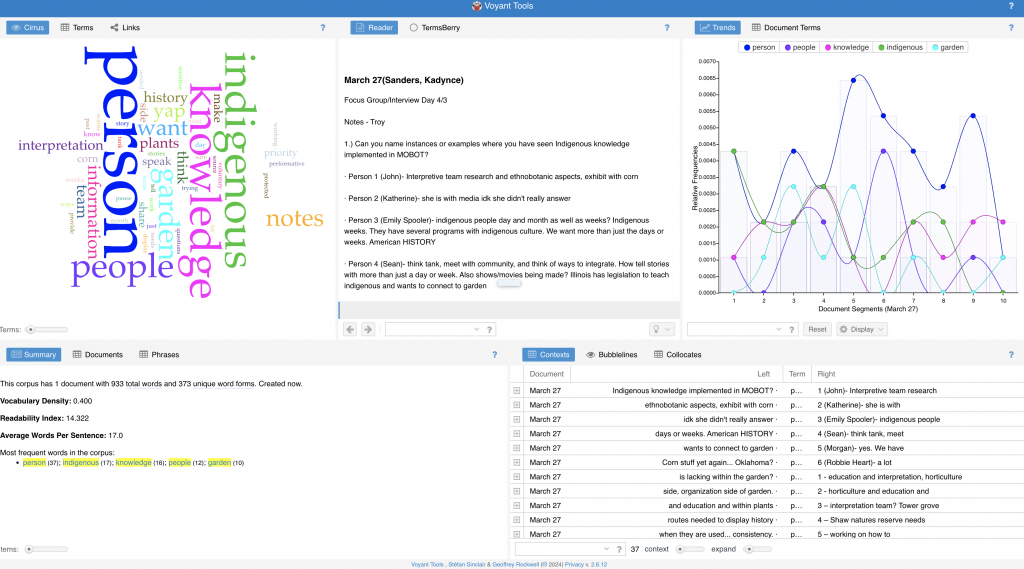

Resources
“What Is Data Cleaning?” Sisense, https://www.sisense.com/glossary/data-cleaning/. Accessed 12 Apr. 2024.
SURVERY PROCESS REFLECTION
The creation of our surveys was a very iterative process requiring great amounts of patience and meticulous refining. Gathering thoughtful and thorough answers from our survey’s participants proved to be quite challenging. It appeared that we had recieved a whopping thirty-three responses but after further investigation, we only had 11 complete responses. More than half of the respondants didn’t finish the survey but instead only paritally completed it. Thankfully, the 11 responses provided us with adequate amounts of insight.
The overarching goal of the survey questions was to gain an understanding of how the current employees at MOBOT perceive the lack of African American representation and knowledge within the herbarium. To get a scope of this we asked questions such as ” What barriers do you perceive in intergrating AA knowledge into the garden?” and ” How well do you think the gardens currently represent AA knowledge and contributions?” Our responses varied slightly but primarily the answers consisted of similar perspectives.
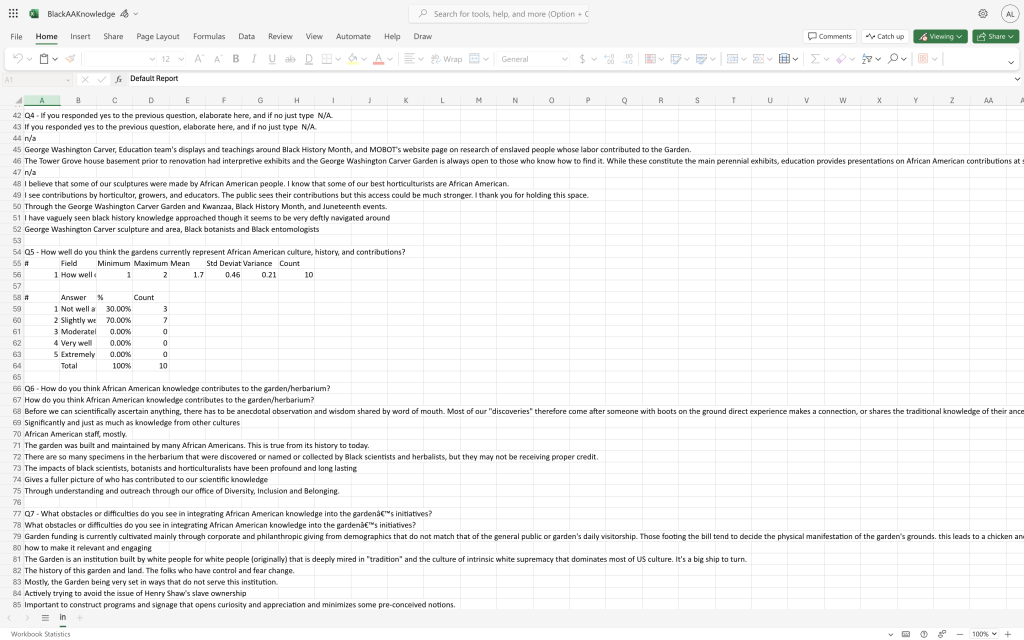
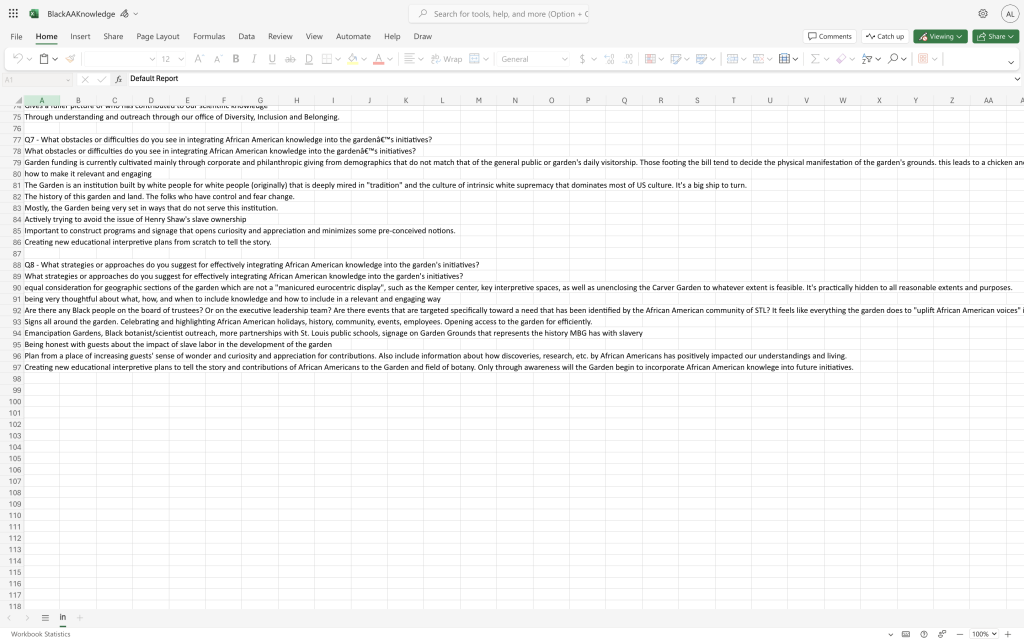
My group also thought it was important to define specifically what we mean by African American knowledge so that their was minimal confusion. We defined it as ” the collective experiences, history, culture, and contributions of people of African descent in America.”
FOCUS GROUP REFLECTION
This was the second step in the process of collecting our data. A well-executed focus group should “help you understand how a particular trait or identity shapes responses to your research question, see how ideas and opinions are formed and shaped through conversation, and allow participants to collaboratively work through a problem.” All three of these criteria were not just met but exceeded. I found that the focus groups were a lot more informative, honest, and in-depth compared to the surveys. I feel like this was because they had no other choice but to sit down and think of a response whereas with a survey you can just exit out of it. There is a fresher, more intense version of accountability imposed onto the participants in a focus group setting which produced more authentic answers.
The way the groups were set up was also really neat as well. The timer being in place to regulate the rotation of the employees was perfectly executed. It allowed us to get a well-rounded set of responses and ideas. We learned about new people who could be potential resources in the future such as Matthew Norman (the rosarian) and Daria Mckelvy. One of the participants highlighted the fact that MOBOT has all of the names of the donors and botanists but not the names of the slaves who helped build it and that stood out to me. I liked that she was able to comfortably highlight the hypocrisy in that. Another thing that stood out to me was a question that Nicole Smith asked. She asked us ” What medium or tool would be most effective for telling the stories and what are our goals as CODES students in telling these stories? ” and I was stumped at that moment. I think the answer to this question is something that we are currently trying to configure.
Attached here is the audio from the focus groups :
Morgan and John focus group.m4a
DATA CLEANING AND VISUALIZING REFLECTION
Data cleaning is the process of identifying and correcting errors, inconsistencies, and inaccuracies in a data set to improve its quality and reliability for analysis. These steps can include identification of errors, correcting inconsistencies, and handling potential outliers. Data cleaning is a crucial step in the data analysis process as it helps improve the accuracy and reliability of analytical results, leading to more informed decision-making. This process was the most tedious when it came to transcribing the audio from the focus groups to ensure that everything properly corroborated.
Similarly, data visualization is the graphical representation of data and information using visual elements such as charts, graphs, and maps. The primary goal of data visualization is to communicate complex data in a clear and concise manner, making it easier for users to understand patterns, trends, and insights within the data. Me and my group members were able to achieve this through a site called Voyant. Voyant is a text analysis and visualization platform that identifies word frequency. It also provides options such as bubble lines, word trees, and scatter plots, to explore textual data in different ways. Attached below is the result of our engagement with Voyant.
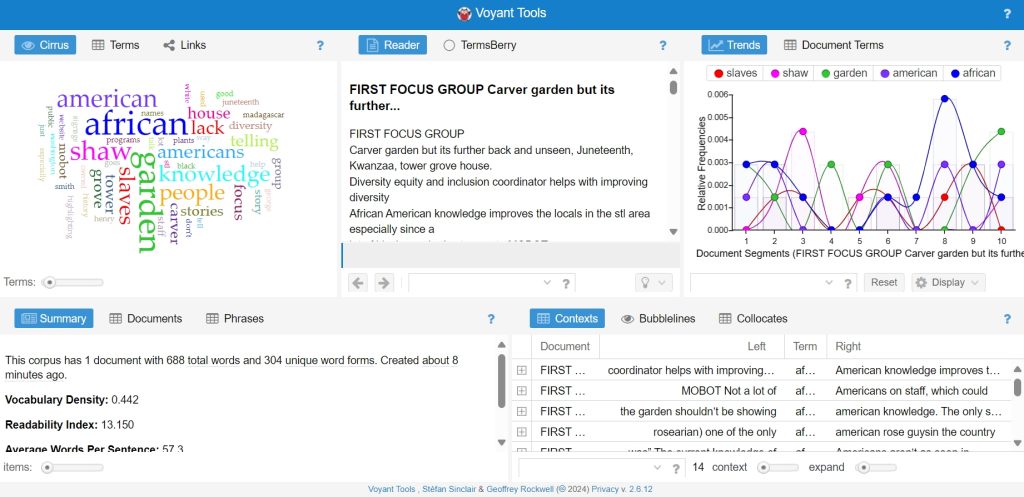
Source 1-
The Himalayas cover a vast mountain range of over 2,500 miles located in China, Bhutan, India, Nepal, and Pakistan (Himalayas – an Overview | ScienceDirect Topics). This specific part of the world has been described as “one of the most botanically rich alpine areas in the world” (Martin). The Missouri Botanical Garden had a group of botanists travel to track the change of temperatures among the plants within a 1-1-meter plots and comparing these plants to the same plants from past years. “[The locals] can’t find the plants they normally gather for medicine, incense, or food… because the plants aren’t growing in the same place, aren’t blooming at the same time of year, or are declining in quality” (Martin).
This study done by MOBOT has proven helpful for locals because through this study a threatened wild plant have a sustainable substitute plant found. This substitute plant would be checked by local people and doctors to ensure the cultural value is the same.
This source is important because it shows the rest of the world how real climate change is and to give solid evidence instead of just feelings.
The audience for this source is peoples who are interested in Indigenous knowledge and ethnobotany.
One note I had made from this article is that I found it kind of odd that all of the direct quotes were made from the same person, Robbie Hart. The garden has pushed for the inclusion of outside voices, but when there is an opportunity for those voices and opinions to be included, the only voice that is given is by a white man that appeared to be in charge of the entire process.
Himalayas – an Overview | ScienceDirect Topics. https://www.sciencedirect.com/topics/earth-and-planetary-sciences/himalayas#:~:text=The%20Himalaya%20constitutes%20an%20impressive,abode%20of%20snow%E2%80%9D%20in%20Sanskrit. Accessed 13 Feb. 2024.
Martin, Catherine. “Highs and Lows: How Climate Change Is Impacting People and Plants in the Himalayas.” Missouri Botanical Garden, 8 Dec. 2023, https://discoverandshare.org/2023/12/08/highs-and-lows-how-climate-change-is-impacting-people-and-plants-in-the-himalayas/.
Source 2-
A library located in Vancouver made the decision to change the way that books were categorized in their library. The Xwi7xwa (whei-wha) aims to better reflect Indigenous knowledge peoples instead of from a colonial bias. These librarians of the Xwi7xwa want to get to know visitors on a “physical, emotional, mental, and spiritual level” (Worth). From the standard Dewey Decimal Classification system, Indigenous books are categorized with the folklore and fairytales compared to biblical information which is located in the nonfiction section. The work of the Xwi7xwa librarians has been revolutionary in the Indigenous community for the better.
This source allows the voices of the Indigenous to be heard compared to the previous article that only allowed one voice to be over powerful compared to the voices that needed to be heard.
This source teaches us that the opportunities to put the correct point of views to light helps round the story and take a full grasp of its entirety.
The source’s main claim is that from the first classification of book organization in libraries (Dewey Decimal Classification) “the systems also can’t easily incorporate Native American languages that use non-Roman characters in the spelling of certain words” (Worth).
Worth, Sydney. “This Library Takes an Indigenous Approach to Categorizing Books – YES! Magazine Solutions Journalism.” YES! Magazine, 29 Mar. 2019, https://www.yesmagazine.org/social-justice/2019/03/22/decolonize-western-bias-indigenous-library-books.